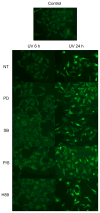Regulation of MSK1-Mediated NF-κB Activation Upon UVB Irradiation
- PMID: 24033137
- PMCID: PMC3937298
- DOI: 10.1111/php.12163
Regulation of MSK1-Mediated NF-κB Activation Upon UVB Irradiation
Abstract
Nuclear Factor Kappa-B (NF-κB) is a transcription factor that controls expression of genes involved in the immune and inflammatory responses as well as being a key component in the onset of cancers. In this study, we provided evidence that mitogen- and stress-activated protein kinase (MSK1) is responsible for a noncanonical late-phase activation of NF-κB upon UVB irradiation. Our data demonstrated that following UVB irradiation, MSK1 is activated via phosphorylation at the 24 h time point coinciding with translocation of NF-κB into the nucleus. Investigations into the signaling pathways upstream of MSK1 through the use of specific inhibitors for mitogen-activated protein kinase and p38 revealed that both kinases are required for full phosphorylation during the late phase (24 h), while p38 is paramount for phosphorylation during the early phase (6 h). Electromobility shift assays (EMSA) showed that inhibition of MSK1 resulted in a marked reduction in NF-κB binding affinity without altering the nuclear translocation of NF-κB. Supershift EMSA implicate that the p65, but not p50, isoform of NF-κB is involved in late-phase activation in response to UVB irradiation. Together, the results of these studies shed light onto a novel pathway of MSK1-mediated late-phase activation of NF-κB in response to UVB irradiation.
Published 2013. This article is a U.S. Government work and is in the public domain in the USA.
Figures






References
-
- Pahl HL. Activators and target genes of Rel/NF-kappaB transcription factors. Oncogene. 1999;18(49):6853–66. - PubMed
-
- Dolcet X, Llobet D, Pallares J, Matias-Guiu X. NF-kB in development and progression of human cancer. Virchows Arch. 2005;446(5):475–82. - PubMed
-
- Chen G, Hardy K, Bunting K, Daley S, Ma L, Shannon MF. Regulation of the IL-21 gene by the NF-kappaB transcription factor c-Rel. J Immunol. 2010;185(4):2350–9. - PubMed
-
- Dev A, Iyer S, Razani B, Cheng G. NF-kappaB and innate immunity. Curr Top Microbiol Immunol. 2011;349:115–43. - PubMed
-
- Wang YJ, Lu J, Wu DM, Zheng ZH, Zheng YL, Wang XH, et al. Ursolic acid attenuates lipopolysaccharide-induced cognitive deficits in mouse brain through suppressing p38/NF-kappaB mediated inflammatory pathways. Neurobiol Learn Mem. 2011;96(2):156–65. - PubMed
Publication types
MeSH terms
Substances
Grants and funding
LinkOut - more resources
Full Text Sources
Other Literature Sources
Research Materials

